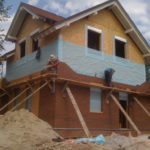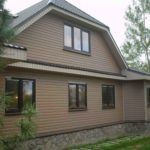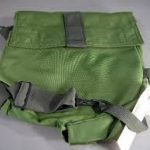Content
- 1 Advantages and disadvantages
- 2 Types of clinker tiles
- 3 Methods of installing the facade of the house
- 4 Calculation of the required amount of material
- 5 Glue selection
-
6 Styling technology
- 6.1 Foundation preparation
- 6.2 Installation of clinker tiles
- 6.3 Grouting and grouting
- 7 Video
- 8 A photo
To give the outer walls of residential cottages the maximum level of resistance to negative environmental factors, you need to think carefully about the actual finishing material. Let's talk about what characteristics the finished facade of a clinker tile house will have and what advantages this material differs.
Advantages and disadvantages
Clinker tile for the facade is quite popular in the domestic market of finishing materials for a long time. Such a trend can be explained by high operational characteristics, as well as the high aesthetics of the facade of private houses with such a finish.
If you want to admire the attractive appearance of your home for a long time, then you should look at the technical characteristics of the clinker.
The main advantages of cladding made with clinker tiles for the facade are such qualities as:
- high frost resistance due to homogeneous, finely porous structure. Facing a house with such material will not become cracked even in the harsh season;
- excellent strength, so it is not afraid of abrasion;
- resistance to chemicals;
- resistance to ultraviolet radiation, therefore, does not fade and does not fade in the sun;
- hygiene - does not allow mold bacteria, fungus to develop on the facade;
- fire resistance, which increases the safety of the home;
- long service life;
- ability to absorb water;
- practicality, resistance to chemicals;
- easy care, the ability to easily clean with ordinary water;
- lightweight masonry technology due to non-slip surface;
- in view of the wide choice of colors and the diverse texture of the material, clinker cladding looks luxurious, stylish, expensive. The following photo with the image of such residential buildings will help to verify this.
Clinker panels for the facade have several disadvantages:
- fragility of the material, as it is made of ceramic;
- high cost when compared with conventional tiles. But in fairness, we add that, unlike a standard brick, clinker is much cheaper.


Types of clinker tiles
Before purchasing the actual amount of material, you need to determine its type. Clinker has several varieties, each of which differs in basic properties and application technology:
- technical, used for the purpose of paving roads, in the arrangement of sidewalks, pedestrian zones, as well as the organization of floors in public buildings;
- waterproof, used for hydraulic structures;
- facade, used in the decoration of external walls of buildings. This finish is used on the facade of any type;
- clinker thermal panels provide the external walls of the house with not only high resistance to wear, but also additional insulation.
Let's talk in detail about clinker tiles for the facade of the house. This kind of clinker, in turn, is divided into subgroups based on certain parameters.
| Selection Parameter | Tile characteristic |
| Tone |
|
| Dressing |
|
| Price |
|

Methods of installing the facade of the house
Clinker thermal panels for the facade are installed in several ways. The choice of a specific one is determined by the shape of the clinker material. Let's talk about them in more detail:
- the wet method involves the installation of clinker tiles on the base using adhesive. In this case, it is possible to carry out additional insulation of the facade with mineral wool or polystyrene. This is a rather time-consuming and dirty way to install a clinker tile facade for residential buildings, however if you have the skills in such matters, you can put it into practice in a short period of time time;
- dry installation of clinker. It is used exclusively for clinker type panels. They are made in the form of a whole set of elements that have special fasteners for connecting into a single facade. Elements are fastened together among themselves on a special basis - expanded polystyrene or expanded polypropylene. It takes much less time to finish this kind, and even a skeptic will please the results.


Calculation of the required amount of material
In order not to spend extra money, you will need to determine exactly how much finishing material is required to clad the external walls of a particular building. It is not difficult to calculate the actual amount of finishing material yourself if you know the size of two types of clinker tiles:
- main - measurements are carried out in square meters;
- angular - in this case, the unit of measurement is a running meter.


Next, you need to measure the length and height of the apartment building using a measuring tape, and then multiply these values among themselves. So you get the total area of the residential building, from which it is worth subtracting the area of unnecessary elements: windows, doorway, because they are not covered with clinker finish, which means less finishing is required.

Experienced manufacturers often indicate the actual amount of material per sq m, taking into account the dimensions of the tile joint. If you want to reduce the seam, you will need to perform the calculations yourself. However, manufacturers do not recommend following this path.
Glue selection
To fix the material on the base, special adhesive compositions are used. They are superimposed on the primed wall surface using a notched trowel, as well as on the back of the clinker.
The type of glue is selected carefully, since there are compositions for external and internal work. When facing external walls, the best choice is a high-quality product with high resistance to frost and high humidity. For example, Ceresit CM 117. Such a composition dries quickly, and wears out for an extremely long time.
Well, if the glue and grout for clinker are made by one manufacturer. Then the compatibility of these materials will be maximum.

Styling technology
Clinker facade tiles demonstrate a long service life and high resistance to factors environment, therefore, is actively used as a cladding of the external walls of residential cottages and other buildings destination. But the material may lose these qualities if its installation is completed with errors, inconsistently, in a hurry.

The technology of laying the material does not differ in an increased degree of complexity, therefore, it may well be performed without the involvement of a hired team of professional builders. But in the process of doing the work, you need to follow certain rules and recommendations of the manufacturer of building materials. We will tell you more about them.
It is better to make a tub of clinker tiles for building facades in good weather without precipitation, on days when the air temperature approaches 20 ° Celsius. The whole sequence of operations can be divided into several stages. We will tell you about them in detail.


Foundation preparation
At the beginning of the work, you need to carefully prepare the base so that its lining is obtained as long as possible, resistant to wear. It is necessary to achieve a perfectly smooth surface, for which the base is washed, cleaned of dust. If there is an old finish on it, it must be carefully removed. If the walls of the house have defects, they will need to be eliminated: the ledges, bulges should be cut with an ax, and the dents, troughs, cracks should be puttied. Also note that the walls of the house from the outside before finishing should be solid and dry, so work should only begin in dry weather.

As soon as preparatory operations are completed, they proceed to priming the base. This procedure increases the adhesion of finishing materials, both with the base and with each other. To do this, they select a special soil emulsion in liquid form, a plastic container under the soil and a wide roller or brush on a long handle. After the primer mixture has dried on the walls, you can proceed to the installation of the cladding.
Installation of clinker tiles
It is not necessary to cover with glue the entire base, if it is large in area. In the process, the composition may dry. The main rule that should be followed during the installation of the clinker is this: do not allow the superiority of the thickness of the mixture for laying the clinker over the mark of more than 1 cm. In case of violation of this condition, the material will be less resistant to wear and will quickly succumb to destruction.

Lubricate the wall area under two rows of clinker tiles. The facing clinker itself is laid out in rows, starting from the second row from the floor, and moves from bottom to top. It is also important to smear the clinker itself from the back, having previously treated it with water or soil.
In order to control the width of the seam between the tiles, you need to set crosses.

For pressed tiles, the recommended joint size is 5 mm, for extruded tiles - 10 mm. After installing the clinker tiles on the wall surface, wait 24 hours, and only then proceed to repairing the joints between the tiles.
Grouting and grouting
The following photo shows the house, the facade with clinker tiles. An important step in the implementation of such a facade of a private house is the sealing and grouting of joints between tiles.

The technology for aligning seams between the rows of clinker has its own specifics, in contrast to the use of conventional tiles. Tiles are laid out so that the seams intersect each other crosswise. And they are aligned through the use of crosses. When it comes to brick clinker, then the seams must be aligned using a round rod. The optimal diameter of such a tool is 6-8 mm. It needs to be put on top of the row passed and densely fill the place of its contact with the base, thereby preventing the clinker from warping.

Next, they wait a little so that the adhesive composition dries, and the rod is removed. The seam is smooth, neat, beautiful, and if you want to make it colored, then after dismantling the rod, the remaining space from it is filled with special grout.
Video
The video perfectly demonstrates how to lay clinker tiles on the facade of a building.
A photo
The collection contains photographs of buildings whose facades are decorated with clinker tiles.




















-
 The design of the facades of one-story houses, photo examples
The design of the facades of one-story houses, photo examples
-
 How to paint the facade and is it possible to do it
How to paint the facade and is it possible to do it
-
 The design of the facades of two-story houses, photo options
The design of the facades of two-story houses, photo options
-
 Facades for SIP houses, possible finishes
Facades for SIP houses, possible finishes
-
 Types of facades of private houses, photo examples
Types of facades of private houses, photo examples
-
 Finishing the facades of private houses with bark beetle plaster, photo options
Finishing the facades of private houses with bark beetle plaster, photo options
-
 Facing brick for facade decoration, its options
Facing brick for facade decoration, its options
-
 Facade of a house for siding, tips and options
Facade of a house for siding, tips and options
-
 What is a wet facade finish?
What is a wet facade finish?
-
 Advantages and disadvantages of ventilated facades made of composite panels
Advantages and disadvantages of ventilated facades made of composite panels
-
 Will pouches come in handy at a construction site?
Will pouches come in handy at a construction site?
-
 Features and order of construction expertise
Features and order of construction expertise
New publications are published daily on our channel in Yandex. Zen
Go to Yandex. Zen


